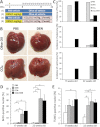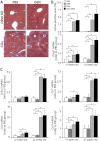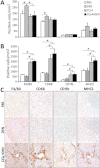Molecular mechanisms of fibrosis-associated promotion of liver carcinogenesis
- PMID: 23288052
- PMCID: PMC3576012
- DOI: 10.1093/toxsci/kfs342
Molecular mechanisms of fibrosis-associated promotion of liver carcinogenesis
Abstract
Hepatocellular carcinoma (HCC) mostly develops in patients with advanced fibrosis; however, the mechanisms of interaction between a genotoxic insult and fibrogenesis are not well understood. This study tested a hypothesis that fibrosis promotes HCC via a mechanism that involves activation of liver stem cells. First, B6C3F1 mice were administered diethylnitrosamine (DEN; single ip injection of 1mg/kg at 14 days of age). Second, carbon tetrachloride (CCl(4); 0.2ml/kg, 2/week ip starting at 8 weeks of age) was administered for 9 or 14 weeks to develop advanced liver fibrosis. In animals treated with DEN as neonates, presence of liver fibrosis led to more than doubling (to 100%) of the liver tumor incidence as early as 5 months of age. This effect was associated with activation of cells with progenitor features in noncancerous liver tissue, including markers of replicative senescence (p16), oncofetal transformation (Afp, H19, and Bex1), and increased "stemness" (Prom1 and Epcam). In contrast, the dose of DEN used did not modify the extent of liver inflammation, fibrogenesis, oxidative stress, proliferation, or apoptosis induced by subchronic CCl(4) administration. This study demonstrates the potential role of liver stem-like cells in the mechanisms of chemical-induced, fibrosis-promoted HCC. We posit that the combination of genotoxic and fibrogenic insults is a sensible approach to model liver carcinogenesis in experimental animals. These results may contribute to identification of cirrhotic patients predisposed to HCC by analyzing the expression of hepatic progenitor cell markers in the noncancerous liver tissue.
Figures




Similar articles
-
Differentially expressed MicroRNAs provide mechanistic insight into fibrosis-associated liver carcinogenesis in mice.Mol Carcinog. 2016 May;55(5):808-17. doi: 10.1002/mc.22323. Epub 2015 Apr 11. Mol Carcinog. 2016. PMID: 25865624
-
TLR4 Deficiency Protects against Hepatic Fibrosis and Diethylnitrosamine-Induced Pre-Carcinogenic Liver Injury in Fibrotic Liver.PLoS One. 2016 Jul 8;11(7):e0158819. doi: 10.1371/journal.pone.0158819. eCollection 2016. PLoS One. 2016. PMID: 27391331 Free PMC article.
-
The DEN and CCl4 -Induced Mouse Model of Fibrosis and Inflammation-Associated Hepatocellular Carcinoma.Curr Protoc Pharmacol. 2014 Sep 2;66:14.30.1-14.30.10. doi: 10.1002/0471141755.ph1430s66. Curr Protoc Pharmacol. 2014. PMID: 25181010 Free PMC article.
-
Standardization of diethylnitrosamine-induced hepatocellular carcinoma rat model with time based molecular assessment.Exp Mol Pathol. 2021 Dec;123:104715. doi: 10.1016/j.yexmp.2021.104715. Epub 2021 Oct 23. Exp Mol Pathol. 2021. PMID: 34699901
-
Human amniotic epithelial cell transplantation induces markers of alternative macrophage activation and reduces established hepatic fibrosis.PLoS One. 2012;7(6):e38631. doi: 10.1371/journal.pone.0038631. Epub 2012 Jun 14. PLoS One. 2012. PMID: 22719909 Free PMC article.
Cited by
-
Liver Cancer: Therapeutic Challenges and the Importance of Experimental Models.Can J Gastroenterol Hepatol. 2021 Feb 28;2021:8837811. doi: 10.1155/2021/8837811. eCollection 2021. Can J Gastroenterol Hepatol. 2021. PMID: 33728291 Free PMC article. Review.
-
Seven immune-related genes prognostic power and correlation with tumor-infiltrating immune cells in hepatocellular carcinoma.Cancer Med. 2020 Oct;9(20):7440-7452. doi: 10.1002/cam4.3406. Epub 2020 Aug 20. Cancer Med. 2020. PMID: 32815653 Free PMC article.
-
Epigenetically mediated inhibition of S-adenosylhomocysteine hydrolase and the associated dysregulation of 1-carbon metabolism in nonalcoholic steatohepatitis and hepatocellular carcinoma.FASEB J. 2018 Mar;32(3):1591-1601. doi: 10.1096/fj.201700866R. Epub 2018 Jan 3. FASEB J. 2018. PMID: 29127188 Free PMC article.
-
Pathogenesis of Type 2 Epithelial to Mesenchymal Transition (EMT) in Renal and Hepatic Fibrosis.J Clin Med. 2015 Dec 30;5(1):4. doi: 10.3390/jcm5010004. J Clin Med. 2015. PMID: 26729181 Free PMC article. Review.
-
The value of CDC42 effector protein 2 as a novel prognostic biomarker in liver hepatocellular carcinoma: a comprehensive data analysis.Osong Public Health Res Perspect. 2023 Dec;14(6):451-467. doi: 10.24171/j.phrp.2023.0229. Epub 2023 Dec 15. Osong Public Health Res Perspect. 2023. PMID: 38204425 Free PMC article.
References
-
- Alkofer B., Lepennec V., Chiche L. (2011). Hepatocellular cancer in the non-cirrhotic liver. J. Visc. Surg. 148, 3–11 - PubMed
-
- Becker F. F. (1983). Thioacetamide hepatocarcinogenesis. J. Natl. Cancer Inst. 71, 553–558 - PubMed
-
- Braeuning A., Jaworski M., Schwarz M., Köhle C. (2006). Rex3 (reduced in expression 3) as a new tumor marker in mouse hepatocarcinogenesis. Toxicology. 227, 127–135 - PubMed
Publication types
MeSH terms
Substances
Grants and funding
LinkOut - more resources
Full Text Sources
Other Literature Sources
Medical
Molecular Biology Databases
Research Materials
Miscellaneous

